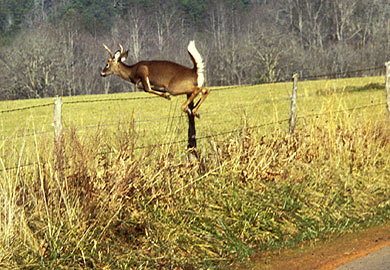DNR News
** Archived Article - please check for current information. **
September 26, 2014Motorists need to watch for deer on state roads
Motorists throughout the state need to be constantly aware of roaming white-tailed deer, according to a state deer biologist.
Despite a persistent rumor, neither the S.C. Department of Natural Resources (DNR) nor any other state agency will compensate motorists for injuries or damages resulting from deer collisions. Besides practicing safe and defensive driving techniques, each motorist should carry adequate collision and comprehensive insurance.
“As the states’ human population increases and more people move to the country which increases commuting traffic, increases in deer-human encounters should be expected,” said Charles Ruth, DNR Deer/Turkey Program coordinator.
The S.C. Department of Public Safety reported approximately 2,200 deer-vehicle collisions in 2013, similar to figures from the last few years. These figures are lower than those reported in the late 1990’s when the incidence of deer-vehicle collisions seemed to peak in the state, however, this decline may have more to do with changes in reporting criteria or lack of reporting for minor damages than with an actual reduction in collisions, according to Ruth.
Although deer-vehicle collisions are an issue in South Carolina, the state is in a much better position than most states, particularly states in the Northeast and upper Midwest. Many states have 30,000-50,000 deer-vehicle collisions annually.
“Sound deer management through regulated annual harvests is the most effective way of curtailing deer-vehicle collisions,” Ruth said, “but following some common sense rules for driving defensively in deer country will make the trip safer.”
White-tailed deer are masters at evading predators, according to Ruth. However, these same predator-avoidance instincts often cause deer to bolt in front of oncoming vehicles.
When deer are sighted well ahead of the vehicle, Ruth recommends sounding the horn several times, flicking headlights (if no oncoming traffic is present) and reducing the vehicle’s speed. If deer are sighted only a short distance in front of the vehicle, these same collision-avoidance techniques - horn and flicking lights - may spook the deer into running across the road, thereby increasing the likelihood of a collision, so in that case it’s best to just slow down.
Always anticipate another deer if you see one or more crossing the highway and do not expect the deer to get out of the way. Fortunately, deer-vehicle collisions typically involve damage to the vehicle rather than human injuries. Most serious injuries occur when the motorist loses control of the vehicle and hits an immovable object like a tree or embankment while
attempting high risk maneuvers to avoid a deer. If a collision with a deer is imminent, it is best to hit the deer rather than risk losing control of the vehicle.
Motorists should understand that deer-crossing signs - diamond-shaped signs bearing the silhouette of a deer - mark a stretch of road where deer have been hit previously, however, these signs do not mark specific deer trails. Deer may frequently cross for several miles where the signs are posted. Studies show that about 45 percent of deer-vehicle collisions occur in roughly a 60-day period that corresponds with the deer-breeding season. In South Carolina, the deer-breeding season, or “rut,” is generally during the months of October and November.
roughly a 60-day period that corresponds with the deer-breeding season. In South Carolina, the deer-breeding season, or “rut,” is generally during the months of October and November.
Deer movements - and vehicle collisions - are at their peak during the breeding season in October and November. Also, most vehicle collisions occur near sun-up and sun-down because deer tend to move more during these times. Unfortunately, these are also the times that most humans commute to work in their vehicles.
“Pay attention to changes in habitat types along the highway,” he said. “The zone between habitat types is a likely place for deer to cross a road. Creek bottoms and where agricultural fields meet woodlands are also prime areas for deer to cross roadways.”
Rural or secondary roads rank highest in deer-vehicle accidents because of the frequent curves and narrow shoulders. Motorists often have little warning and therefore limited reaction time when they see deer.
South Carolina’s deer population peaked in the late 1990’s as did the number of deer vehicle collisions. Fortunately, thanks to efforts by hunters in addressing the increasing population deer numbers have moderated since 2000 and the statewide population is estimated to be about 25 percent less now than 10 years ago.
What should motorists do if they hit a deer? “Report the incident to the state Highway Patrol or local law enforcement and to your insurance company,” Ruth said. Finally, many people wonder if they can keep the deer for consumption. This it is not a problem as long as there is an incident report demonstrating that the deer was killed by a vehicle and not illegally shot.
More News
- Waterfowl hunt application process is now open
- DNR honors 2014 Law Enforcement Officers of the Year
- Wood duck box applications available until Nov. 1
- Numerous Hunter Education classes added to the Upstate
- Shellfish season will open Oct. 1 in South Carolina
- Proper disposal of deer remains is a rule of good hunter ethics
- Deer hunting returns to Bonneau Ferry WMA
- Longleaf pine trees shedding needles is normal this time of year
- Motorists need to watch for deer on state roads
- Student Angler League Tournament Trail conducts first tourney
- Late-season migratory bird regulations set
- Pee Dee Scenic Rivers public opinion survey report available
- All-time antler records update now available on DNR website
- Freshwater fishing trends
- Saltwater fishing trends
- S.C. weekly tidetable
- DNR video
- Archived news releases
